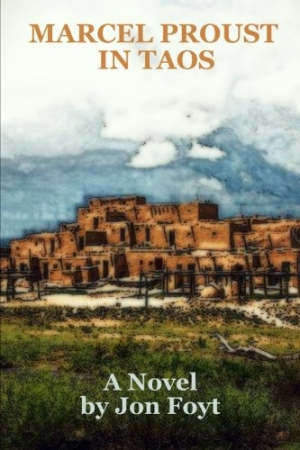Marcel Proust in Taos
In Search of Times Past
Real, engaging characters make for a relaxing summer read.
Although he never utters a word or a sound in the text, the titular character of Jon Foyt’s charming romance is a white Angora cat who helps the principal character with both his writing and his love life. The cat, as the author notes, is the only one of three main characters in Marcel Proust in Taos to be welcomed by the rather sour, stuck-up, and well-to-do citizens of the desert city of the title.
Christopher, the retired nuclear physicist Marcel lives with, and the German artist he and Marcel come to love, eventually find a clever way to fit in with most of the locals, but their uphill battle is part later-in-life love story, part cautionary tale, and part immigrant saga. There is much to like in this novella, but the sixty pages the author devotes to the publishing of his principal human character’s book are major distractions that break the pace of the narrative.
The character of Oscar, whom Christopher creates in that novel within a novel, does speak to his creator, but it is in voices the reader is not privileged to hear (Christopher notes the conversations in asides). Although Red Willow Prophecy, the novel Christopher is writing, does have some bearing on the plot, it is marginal, especially considering that the basic story is a rather good one, with real, engaging, and genuinely nice characters.
Chief among these is Marlene, the German immigrant who has come to Taos to pursue her dream of being an artist, only to be frustrated and denigrated by the local elite. “My clients buy prestige, not necessarily good art,” says a snooty gallery owner who will not lower himself to even glimpse her portfolio. A wealthy dowager considers commissioning her to do a painting for her house, stipulating that its colors “must not clash with my new draperies.” Marlene’s response is worth the price of the book.
Although insulted by being told to give up her artistic dreams and “open a beer hall,” Marlene does just that, with a little help from Christopher. What happens then is grist for the second half of the book. While most of the novel is rather lighthearted, it does turn dark and deadly in the final chapter, which may leave many readers unhappy.
Foyt turns some very nice phrases, and his main story is a light and relaxing read—perfect for a summer’s afternoon beneath the desert palms. While editing down much of the novel within a novel would trim the already short book by a third, it would greatly enhance the work by improving its pace, removing unwelcome distractions, and helping the reader better focus on the delightful characters.
Reviewed by
Mark McLaughlin
Disclosure: This article is not an endorsement, but a review. The publisher of this book provided free copies of the book and paid a small fee to have their book reviewed by a professional reviewer. Foreword Reviews and Clarion Reviews make no guarantee that the publisher will receive a positive review. Foreword Magazine, Inc. is disclosing this in accordance with the Federal Trade Commission’s 16 CFR, Part 255.

